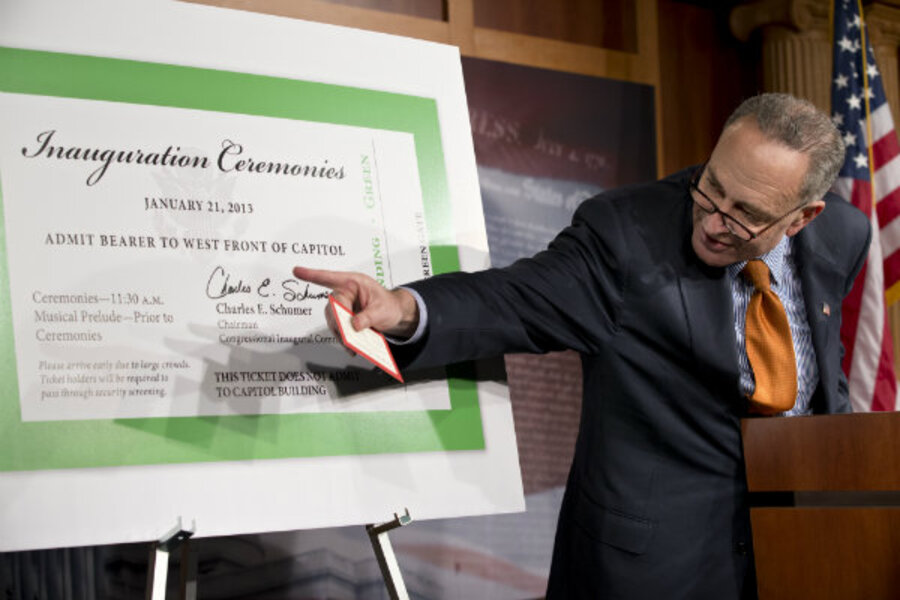Americans want a good inauguration show – corporate funding or not
Loading...
| Abu Dhabi, United Arab Emirates
On March 4, 1801, Thomas Jefferson walked from a nearby boardinghouse to the Capitol to be inaugurated as the third president of the United States. His two predecessors, George Washington and John Adams, had arrived at their own inaugurations by stagecoach, clad in elegant suits.
But Jefferson went on foot, wearing the clothes “of a plain citizen without any distinctive badge of office,” as a Virginia newspaper reported. Jefferson swore his presidential oath, gave a brief speech, and then walked back to have dinner with his fellow boarders.
Fast-forward to this Monday, when President Obama will be inaugurated for his second term. Citing the struggling economy, organizers have scaled the celebration back from his first inauguration, when they raised a record $53 million in private donations. But this year’s festivities will still feature plenty of glitz and glam, including performances by Beyoncé and Kelly Clarkson. And it will be funded in part by corporate donations and large individual gifts, which Mr. Obama renounced the last time around. In the wake of the November elections, the Obama camp said it would be hard to raise still more money from “campaign weary” donors.
And most Americans seem ok with that. Sure, Obama’s fundraising for next week's inauguration has drawn barbs from Public Citizen and a Republican organization called GOP.com. But I haven’t noticed anyone complain about all of the inaugural glamour, even if most of us won’t get anywhere near it. The big events are all invitation-only, and only big donors will get in.
Institutions giving $1 million or individuals contributing $250,000 to the inauguration festivities will earn the coveted “Washington” designation, receiving exclusive access to the inauguration’s two balls (down from 10 last time) and other events. Next comes the “Adams” group, at $500,000 and $150,000, respectively. After that is – you guessed it – the “Jefferson” level: $250,000 for corporations and $75,000 for individuals. And there are a few more rungs below that.
All that cash will pay for lots of pomp and circumstance, which is what Americans really want. Despite Thomas Jefferson’s pleas for “republican simplicity,” the citizens of the republic have generally favored loud and lavish festivities when they install a president – and even when they re-elect one. The only questions have been who gets to participate, and who picks up the tab.
The first great “people’s president” was Andrew Jackson, a war hero who lacked the wealth and privilege of Jefferson and other prior leaders. Fittingly, then, Jackson’s 1829 inaugural was also the first truly mass celebration in Washington, D.C.
And how the masses did celebrate! Jackson was overrun at the Capitol by a huge mob, which broke through a chain and pursued him all the way to the Executive Mansion. Crowds later rushed into the mansion, breaking china and tearing draperies as they fought to shake hands with the new president. Jackson was forced to escape through a window, while his admirers – fueled by orange punch – continued to party into the night.
To America’s more traditional elites, all of this merrymaking demonstrated the folly of popular rule. “I never saw such a mixture,” declared Supreme Court justice Joseph Story. “The reign of King Mob seemed triumphant.”
Similar worries marked the second inauguration of Abraham Lincoln, in 1865, when hungry visitors raided an invitation-only buffet and made off with silverware, candlesticks, and punch bowls. But poet Walt Whitman – perhaps the era’s best-known tribune of democracy – was charmed rather than alarmed by the revelry. “Never before was such a compact jam in front of the White House,” enthused Whitman, who rushed forward with the crowd.
So did the great African-American abolitionist Frederick Douglass, but he was stopped at the door and told that blacks weren’t allowed any further. Douglass sent word to Lincoln, whom he had met a few months earlier, and the president ordered guards to let him in. “Here comes my friend Douglass,” Lincoln exclaimed. “I am glad to see you.”
Lincoln was assassinated a few weeks later, marking the end of free-for-alls at the White House. Banquets and balls arose in their place, restricted to the select few. “Anyone who is anyone is there,” declared Alice Roosevelt, describing a ball at her father Theodore’s 1905 inauguration, “and a lot of people who are no one try to get in as well.”
Jimmy Carter tried to bring the common touch back to his inauguration in 1977, substituting informal dance parties for black-tie balls. He also walked from the Capitol to the White House, rather than riding in a car.
I was in the crowd that chilly afternoon, a shivering 15-year-old waving happily at the president as he strolled by. In the public press, however, Carter’s down-home efforts received more ridicule than respect. “A few more such ‘people’s parties’ could bring back snobbery,” one columnist sniffed.
And so they did. Fancy balls returned to inaugurations with Ronald and Nancy Reagan, who wore a $22,500 gown on loan from a designer in 1985. Following suit, Michelle Obama’s luxurious 2009 inaugural outfits were the talk of the fashion world, which has been speculating on her 2013 gowns for weeks.
Americans have come to expect nothing less. No matter who parties with the president – or who pays for it – the inauguration is really a party for all of us. Anyone who is anyone will be there.
Jonathan Zimmerman is a professor of history and education at New York University and is currently teaching a three-week course at NYU’s campus in Abu Dhabi. He is the author of “Small Wonder: The Little Red Schoolhouse in History and Memory” (Yale University Press).





